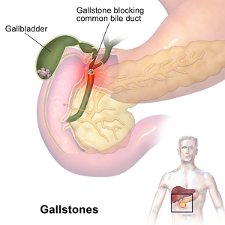Gallstone Disease
The liver produces bile that it drains by the bile duct into the gallbladder and the intestine. The bile is stored in the gallbladder and when you eat it receives signals to squeeze and drain the bile into the bile duct and the intestine. Bile that is high in cholesterol tends to form stones called gallstones.
 Gallstone Disease Symptoms
Gallstone Disease Symptoms
Most people that have gallstones do not experience any symptoms, however sometimes a gallstone can obstruct the gallbladder and prevent it from draining the bile into the intestine. This causes an infection in the gallbladder called Cholecystitis.
Sometimes a gallstone obstructs the gallbladder temporarily and the pain is resolved without any treatment. This is called Biliary Colic and is a condition that predicts a future episode of Cholecystitis.
Other signs and symptoms may alert your doctor that your gallstone disease is not just Biliary Colic, but may be more serious.
If you experience a fever you may be suffering from Acute Cholecystitis. If in addition to a fever, your blood pressure is low, your heart rate is fast, and you are somewhat disoriented you may be suffering from an infection of your liver caused by a gallstone blocking your bile duct. This is called Ascending Cholangitis.
Other symptoms that may occur with or without a fever is yellowing of your skin (Jaundice) and eyes (scleral icterus), as well as, discoloration of your stool (pale).
Gallstone Disease – Diagnosis:
The diagnosis involves a physical examination, sonogram of your gallbladder, blood work and sometimes additional imaging studies as necessary.
Gallstone Disease Treatment: Surgery
Whether you have Biliary Colic, Acute Cholecystitis, Bile duct stones, or Ascending Cholangitis it is recommended that your gallbladder is removed if you can safely undergo surgery. What is different from case to case is the timing of the surgery.
The surgery to remove you gallbladder is called Cholecystectomy and it is usually done laparoscopically, which means through small incisions rather than one big incision. This usually results in less pain, a shorter hospital stay, and a faster return to your normal activities. However, sometimes it cannot be performed safely and a larger single incision may need to be done.
Sometimes, a stone may block your bile duct. This is called Choledocholithiasis. It is sometimes possible to remove the stone from your bile duct endoscopically (this is called ERCP), meaning by sedating you and inserting a camera through your mouth into your stomach and intestine to remove the stone from the bile duct. This is a less invasive procedure than to remove the stone surgically and is often preferred.
Nutritional consideration for patients with gallstones
Common nutrition problems that may arise with gallbladder disease include:
- Fatty stool
- Malabsorption of nutrients
- Fat intolerance
- Abdominal gas
- Indigestion
- Nausea
- Vomiting
Nutrition intervention summarized:
- Vitamin supplementation of water soluble form of Vitamins A, D, E, and K may be warranted
- Symptomatic gallstones, acute attacks, and cholecystitis require a low-fat diet.
- Elimination of foods that cause flatulence.
- Limit refined sugar such as sweetened beverages (juice, soda), candy, desserts and foods with added sugar.
- Choose low fat dairy products such as 1% milk, yogurt, cheese (cottage, ricotta, feta), low fat sour cream, low fat cream cheese.
- Maintain a healthy diet with moderate amounts of fat (20-30% of calories from fat).
It is recommended for patients to consume small, frequent meals throughout the day with snacks. Fat should be limited to less than 30% of your daily calories, make sure to choose low-fat food items. Avoid foods that are fried, have strong odors or are known to cause gas.
It is strongly recommended to consume a well-balanced diet (i.e. fruits, vegetables, whole grains, healthy fats), especially foods high in calcium and Vitamin D to prevent osteoporosis. If lactose intolerance is a barrier, patients may opt to take supplements. Additionally, patients should avoid raw fish, raw seafood, undercooked meat, and unpasteurized dairy products to prevent bacterial infections.